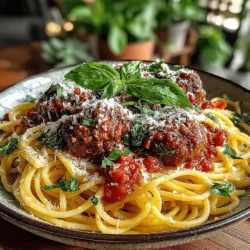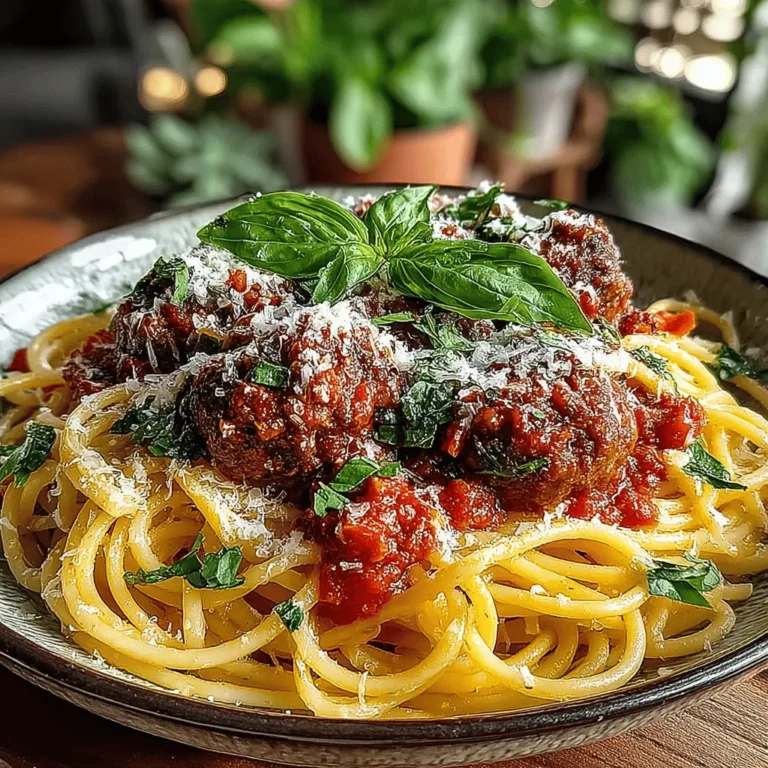Classic Spaghetti & Meatballs: A Culinary Embrace
Few dishes evoke the warmth of home and the comfort of family gatherings quite like classic spaghetti and meatballs. This beloved Italian-American dish has transcended kitchens and cultural borders, becoming a staple on dining tables around the world. Its rich flavors and satisfying textures have made it a go-to meal for generations, encapsulating the essence of hearty, home-cooked comfort.
The origins of spaghetti and meatballs can be traced back to the 19th century when Italian immigrants brought their culinary traditions to America. Over time, this dish evolved, adapting to local ingredients and tastes while still retaining its roots. Today, spaghetti and meatballs is more than just a meal; it is a symbol of togetherness, often served during family celebrations, Sunday dinners, and festive gatherings. The sight of a steaming plate of spaghetti topped with savory meatballs and a rich marinara sauce brings back memories of cherished moments spent around the dinner table, filled with laughter and love.
In this article, we will explore a traditional yet approachable recipe for classic spaghetti and meatballs, perfect for both novice home cooks and seasoned chefs looking to recreate a beloved favorite. This recipe strikes a balance between authenticity and simplicity, allowing you to bring the flavors of Italy into your kitchen with ease.
The Allure of Classic Spaghetti & Meatballs
Spaghetti and meatballs have become synonymous with Italian-American cuisine, but this dish has a fascinating history that reflects the journey of Italian immigrants in the United States. In Italy, meatballs (known as “polpette”) are typically served as a separate dish, often accompanied by a side of vegetables or salad. However, upon arriving in America, the concept of combining pasta with meatballs took hold, leading to the creation of a hearty meal that could feed a crowd.
This dish has earned its place in the hearts of many, often featured prominently in family gatherings, holidays, and even casual weeknight dinners. The preparation of spaghetti and meatballs can be a communal experience, with family members coming together to roll out meatballs, boil pasta, and simmer sauce. Each family has its own unique twist, whether it be a secret ingredient in the meatballs or a specially crafted sauce recipe handed down through generations.
Personal anecdotes often accompany this dish, with many families recalling the first time they made spaghetti and meatballs with loved ones. Whether it was a grandmother’s kitchen filled with the aroma of simmering sauce or a parent’s careful guidance in shaping meatballs, these memories contribute to the dish’s cultural significance. Spaghetti and meatballs are more than just food; they represent love, tradition, and the joy of sharing a meal with those you cherish.
Understanding the Key Ingredients
To create a truly memorable classic spaghetti and meatballs, it is essential to understand the key ingredients that contribute to its delicious flavor and texture.
Ground Beef: The foundation of any good meatball is the meat itself. For the best flavor and texture, opt for ground beef with a fat content of around 80/20. This ratio provides the ideal amount of fat to keep the meatballs juicy and flavorful while preventing them from becoming too greasy.
Breadcrumbs: These play a crucial role in achieving the perfect meatball consistency. Breadcrumbs not only add structure but also help retain moisture, ensuring that the meatballs remain tender. You can use store-bought breadcrumbs or make your own from stale bread for a fresher taste.
Parmesan Cheese and Parsley: A generous sprinkle of grated Parmesan cheese adds depth of flavor to the meat mixture, while fresh parsley brightens the dish with a hint of freshness. These ingredients are essential for achieving the authentic taste that makes spaghetti and meatballs so beloved.
Garlic and Egg: Garlic is a staple in Italian cooking, providing a savory kick to the meatballs. Additionally, the egg serves as a binding agent, helping to hold the mixture together and ensuring that the meatballs maintain their shape during cooking.
Sauce Ingredients: The sauce is just as important as the meatballs. A classic marinara sauce typically features crushed tomatoes as its base, offering a rich, tangy flavor. Balancing the acidity of the tomatoes with a touch of sugar can enhance the overall taste, creating a well-rounded sauce.
Herbs such as oregano and basil are essential for infusing the sauce with traditional Italian flavors. These aromatic herbs contribute to the authenticity of the dish and elevate the overall experience. For those who enjoy a little heat, adding red pepper flakes can bring an exciting kick to the sauce.
Spaghetti and Garnishes: Choosing the right type of pasta is crucial for an optimal dining experience. Traditional spaghetti is the go-to choice, as its long strands are perfect for twirling around a fork, capturing the sauce and meatballs in every bite. To elevate the dish, consider garnishing with fresh basil and a sprinkle of extra Parmesan cheese before serving.
Step-by-Step Guide to Making Meatballs
Now that we’ve covered the essential ingredients, it’s time to dive into the step-by-step process of making perfect meatballs.
1. Preparing the Meatball Mixture: In a large mixing bowl, combine the ground beef, breadcrumbs, grated Parmesan cheese, minced garlic, chopped parsley, and egg. It’s important to mix the ingredients gently, using your hands to incorporate them without overmixing. Overmixing can lead to tough meatballs, so aim for just enough mixing to combine everything evenly.
2. Shaping Techniques: Once the mixture is well combined, it’s time to shape the meatballs. To ensure uniform cooking, use a cookie scoop or your hands to create meatballs of equal size, typically about 1 to 1.5 inches in diameter. This will help them cook evenly, resulting in a delightful texture.
3. Baking vs. Frying Meatballs: While frying meatballs in oil is a traditional method that yields a crispy exterior, baking them is a healthier alternative that also simplifies the cooking process. Preheat your oven to 400°F (200°C) and arrange the meatballs on a baking sheet lined with parchment paper. Bake for about 20-25 minutes or until they are cooked through and browned.
By following these initial steps, you will be well on your way to creating a delicious batch of classic spaghetti and meatballs that will evoke feelings of nostalgia and comfort. This dish not only brings delightful flavors to your table but also creates memorable moments shared with family and friends. Stay tuned for the next part of this article, where we will delve into cooking the pasta, preparing the sauce, and bringing it all together for a truly satisfying meal.
{{image_2}}
Tips on Achieving That Perfect Golden-Brown Crust in the Oven
Creating meatballs with a golden-brown crust is crucial for both flavor and texture. Here are some tips to achieve that perfect crust:
– Use a High Oven Temperature: Preheat your oven to 425°F (220°C). This high heat will help the meatballs sear quickly, giving them a beautiful brown exterior while keeping the inside juicy and tender.
– Don’t Overcrowd the Baking Sheet: Space your meatballs out on the baking sheet. If they’re too close together, they will steam rather than roast, preventing that desirable crust from forming.
– Use a Wire Rack: For even browning, place the meatballs on a wire rack set over a baking sheet. This allows hot air to circulate around the meatballs, enhancing the roasting process.
– Brush with Olive Oil: Before placing the meatballs in the oven, lightly brush them with olive oil. This helps promote browning and adds a subtle flavor.
Crafting the Perfect Sauce
Sautéing Aromatics for a Flavorful Base
The sauce is the heart of your spaghetti and meatballs, and it begins with the right aromatics. Start by finely chopping a medium onion and a few cloves of garlic. Heat a tablespoon of olive oil in a large saucepan over medium heat. Add the onions first, sautéing until they become translucent—about 5 minutes. Then, add the garlic, cooking for another minute until fragrant.
The Importance of Cooking Onions and Garlic Properly
Cooking onions until they are soft and slightly caramelized releases their natural sugars, enhancing the sweetness of the sauce. Garlic must be added later to avoid burning, which can create a bitter taste. Achieving this balance will set a strong flavor foundation for your sauce.
Techniques to Enhance the Flavor Profile During Sauce Preparation
To elevate your sauce, consider adding a splash of red wine after the onions and garlic are sautéed. Allow the wine to reduce for a few minutes, which will deepen the sauce’s flavor. Next, add crushed tomatoes—either canned or fresh—along with a teaspoon of sugar to balance acidity, salt, pepper, and your choice of herbs, such as oregano or basil.
Simmering for Flavor Infusion
Once your ingredients are in the pot, bring the sauce to a gentle simmer. This slow cooking process allows the flavors to meld beautifully. Aim for a simmer of at least 30 minutes; the longer you simmer, the more the flavors develop. Stir occasionally and taste along the way, adjusting seasoning as necessary.
Timing and How to Adjust Seasoning to Taste
Seasoning is key to a delicious sauce. Start with the basics—salt and pepper—but don’t be afraid to experiment with additional seasonings. Dried herbs can be added early on, while fresh herbs should be stirred in just before serving to maintain their vibrant flavor. Always taste your sauce before serving and adjust accordingly.
Cooking the Spaghetti
Importance of Salted Water in Pasta Cooking
Cooking spaghetti properly is just as vital as preparing the sauce. Start by bringing a large pot of water to a rolling boil. Add a generous amount of salt—at least one tablespoon for every quart of water. This not only flavors the pasta but also helps it achieve the right texture.
The Ideal Timing for Achieving That Perfect Al Dente Texture
Follow the package instructions for cooking time, but start checking the pasta a minute or two early. You want your spaghetti to be al dente—firm to the bite. This texture holds up better when tossed with sauce and prevents it from becoming mushy.
Tips for Tossing Spaghetti to Prevent Sticking
Once cooked, drain the spaghetti but do not rinse it. Rinsing washes away the starch that helps the sauce adhere. Instead, immediately toss the hot pasta with a little olive oil to prevent sticking. If you’re serving right away, you can mix the spaghetti directly into the sauce to coat it evenly.
Combining the Elements
Merging Meatballs with Sauce
Once your meatballs are cooked and your sauce is simmering, it’s time to combine the two. Gently place the meatballs into the sauce, ensuring they are submerged. This allows the meatballs to absorb the flavors of the sauce, creating a harmonious dish.
Benefits of Letting the Meatballs Simmer with the Sauce
Allow the meatballs to simmer in the sauce for at least 10 minutes. This not only helps to meld the flavors together but also keeps the meatballs moist and tender. The sauce will also thicken slightly, coating the pasta beautifully.
Visual Appeal of Plating the Dish
When plating your spaghetti and meatballs, use a large serving bowl or individual plates. Twirl the spaghetti onto the plate using a fork or tongs, creating a nest in the center. Nestle the meatballs on top and generously ladle sauce over the dish. For an Instagram-worthy presentation, consider garnishing with freshly grated Parmesan cheese and a sprinkle of chopped parsley.
Serving Suggestions and Presentation
Creative Plating Techniques for an Appealing Presentation
To enhance the visual appeal of your dish, consider using a ring mold to shape your spaghetti neatly. This technique allows for a more refined presentation, especially when hosting a dinner party. Top with a few meatballs and a drizzle of sauce for a stunning finish.
Importance of Garnishes Like Fresh Basil and Olive Oil
A few fresh basil leaves can add a pop of color and flavor. A drizzle of high-quality extra-virgin olive oil right before serving can elevate the dish, adding richness and depth.
Suggestions for Side Dishes That Pair Well with Spaghetti and Meatballs
Complement your classic spaghetti and meatballs with simple side dishes. A crisp green salad with a lemon vinaigrette adds freshness, while garlic bread or a side of roasted vegetables can provide a satisfying crunch.
Nutritional Breakdown
Overview of the Nutritional Content of the Dish
While spaghetti and meatballs are a comfort food staple, it’s important to consider their nutritional content. A typical serving contains protein from the meatballs, carbohydrates from the pasta, and vitamins from the sauce, particularly if you include plenty of vegetables.
Balancing Indulgence with Nutrition
To make this dish a bit healthier, consider using whole wheat pasta, which offers more fiber and nutrients. Leaner meat options, such as turkey or chicken, can also be used for the meatballs without compromising flavor.
Suggestions for Modifications to Cater to Dietary Preferences
For gluten-free diets, substitute traditional spaghetti with gluten-free pasta made from rice or lentils. You can also experiment with spiralized vegetables, such as zucchini or squash, for a low-carb alternative that still satisfies your pasta craving.
Conclusion
The joy of making classic spaghetti and meatballs lies not only in the delightful flavors but also in the experience of sharing this meal with loved ones. The savory aroma wafting through your kitchen is bound to bring everyone together, creating moments of connection and warmth around the dinner table.
Encourage yourself to try this recipe, experiment with the ingredients, and discover your own twist on a beloved classic. As you serve this dish to family and friends, you’ll be reminded of the powerful role food plays in bringing people together, forging lasting memories, and creating bonds that go beyond the dinner plate. So grab your apron, gather your ingredients, and dive into the delicious world of homemade spaghetti and meatballs. Your taste buds—and your loved ones—will thank you!


